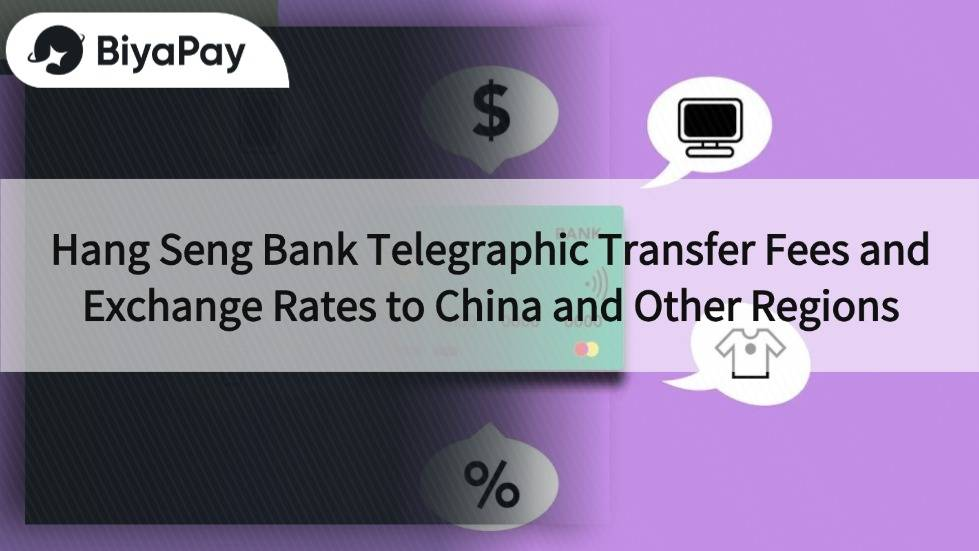- EasyCard
- Trade
- Help
- Announcement
- Academy
- SWIFT Code
- Iban Number
- Referral
- Customer Service
- Blog
- Creator
Hang Seng Bank Telegraphic Transfer Fees and Exchange Rates to China and Other Regions

Image Source: unsplash
When processing a Hang Seng telegraphic transfer, you should first understand the calculation methods for fees and exchange rates. Different regions and currencies affect the fees, and there are significant differences between online banking and branch processing fees. For example, some Hong Kong banks’ online banking telegraphic transfer fees are generally lower than those at branches; for instance, when transferring 30,000 USD through Bank of Taiwan, online fees are approximately 24 USD, while branch fees can be as high as 40 USD. You should also note that Prestige Banking customers may be eligible for fee waivers. When transferring funds, correspondent banks may charge additional fees, and exchange rate fluctuations can also affect the final amount received.
Key Points
- Hang Seng Bank telegraphic transfer fees vary by channel and region, with online banking being cheaper than branches, and Prestige Banking customers may enjoy fee waivers.
- Exchange rates affect the final amount received, with bank rates differing from market rates; it’s advisable to monitor exchange rate trends to choose the optimal transfer timing.
- Before transferring, prepare complete information and confirm any intermediary fees that the receiving bank may charge to avoid insufficient funds reaching the recipient.
- Online banking transfers are faster, with a cutoff time of 5 PM, while branches have a cutoff time of 3 PM; submit instructions early to avoid delays.
- Hang Seng telegraphic transfers are suitable for large cross-border transfers; pay attention to transfer limits and fees, and consider setting up standing instructions for regular transfers.
Hang Seng Telegraphic Transfer Fees

Image Source: pexels
China and Macau
If you use Hang Seng telegraphic transfer to send funds to China or Macau, the fees will vary depending on the channel you choose.
Generally, online banking fees are lower, while branch processing fees are higher. Below is the typical fee range:
| Channel | Fee (USD) | Remarks |
|---|---|---|
| Online Banking | 20 - 25 | Per transaction, depending on amount and currency |
| Branch Processing | 35 - 40 | Per transaction |
You need to note that these fees only include Hang Seng Bank’s own charges. If you choose to settle in USD, the receiving bank or correspondent bank may charge additional fees.
If you are a Prestige Banking customer, you may be exempt from basic telegraphic transfer fees in some cases. You can check your exemption eligibility on the online banking platform.
Tip: When transferring to China, it’s recommended to confirm with the recipient whether the receiving bank will charge intermediary fees to avoid a reduced received amount.
Other Regions
When using Hang Seng telegraphic transfer to send funds to other regions (such as the US, Canada, Europe, etc.), the fees will slightly differ.
The fee structure for different regions is as follows:
- Online Banking: Approximately 25 - 30 USD per transaction
- Branch Processing: Approximately 40 USD per transaction
Some countries or regions’ receiving banks may charge intermediary fees, which will be deducted from the transfer amount. You should check the fee policies of the relevant banks in advance.
If you choose to settle in HKD, Hang Seng Bank will automatically convert to the local currency based on the daily exchange rate, which may affect the final amount received.
Online Banking vs. Branch Comparison
You can choose online banking or visit a branch to process a Hang Seng telegraphic transfer. The main differences are as follows:
| Item | Online Banking | Branch Processing |
|---|---|---|
| Fees | Lower (20-30 USD) | Higher (35-40 USD) |
| Convenience | Operate anytime, anywhere | Requires in-person visit to branch |
| Processing Speed | Faster | Average |
| Standing Instructions Setup | Self-managed | Requires staff assistance |
If you frequently need to transfer funds, consider setting up standing instructions. The online banking platform supports automatic recurring transfers, with fees similar to single transfers. Prestige Banking customers may have some fees waived when using online banking or branches. You should log in to online banking to check the latest offers.
Note: Regardless of the channel chosen, Hang Seng telegraphic transfer fees do not include additional charges from correspondent or receiving banks. You should reserve extra funds to avoid insufficient amounts reaching the recipient.
Exchange Rates and Actual Amount Received
Exchange Rate Calculation
When using Hang Seng telegraphic transfer, the exchange rate calculation directly affects the final amount received. Hang Seng Bank generally converts based on the daily real-time exchange rate. You can check the latest exchange rates on the Hang Seng Bank online banking platform or official website. Exchange rate data sources include Bloomberg and other international financial information providers. The bank updates exchange rates periodically based on market conditions, but the update frequency may be affected by market closures, system transmission, and other factors. If data transmission is interrupted, the bank will use the most recently available exchange rate data for calculations.
You can refer to the following table to understand the basic structure of exchange rate calculations:
| Item | Description |
|---|---|
| Exchange Rate Calculation Method | Division |
| Update Frequency | Monthly or adjusted based on market conditions |
| Default Exchange Rate Options | Previous date, exact date, next date, etc. |
| Exchange Rate Data Source | Bloomberg, Hang Seng Bank Official |
| Remarks | Recommend using “previous date” as the default exchange rate setting |
You can use tools like Excel to fetch online exchange rate information, making it easy to update and compare rates. Since fetching data takes time, updates are typically done only when real-time rates are needed. You should choose an appropriate update frequency based on actual needs.
Tip: The official exchange rate data is not guaranteed to be real-time or accurate, so you should assess risks when checking rates.
Market Exchange Rate Differences
When checking Hang Seng telegraphic transfer exchange rates, you’ll notice differences between the bank’s rates and real-time market rates (e.g., Google, Yahoo Finance). This is because banks adjust rates based on their costs, risk management, and market liquidity.
Bank exchange rates typically include a profit margin, known as the “exchange rate spread.” When converting HKD or USD, the actual rate may be slightly higher or lower than market quotes.
You should note the following:
- Bank exchange rates adjust with market fluctuations.
- The exchange rate spread affects the final amount received.
- Exchange rates may vary significantly between banks; compare rates from several Hong Kong banks.
Note: When choosing a transfer time, observe market exchange rate trends to select a more favorable timing for conversion.
Estimating the Received Amount
When processing a Hang Seng telegraphic transfer, your main concern is how much the recipient will ultimately receive. You need to consider the following factors:
- Exchange Rate: The bank’s exchange rate at the time of conversion directly affects the received amount.
- Fees: Includes Hang Seng Bank’s fees, as well as intermediary and receiving bank fees.
- Settlement Currency: Choosing HKD or foreign currency settlement affects the number of conversions and exchange rates.
You can use the following steps to estimate the received amount:
- Deduct all known fees from the transfer amount (e.g., 25 USD).
- Convert HKD or USD to the recipient’s currency using the bank’s daily exchange rate.
- Reserve extra funds for correspondent or receiving bank fees (typically 10-30 USD).
For example:
If you transfer 1,000 USD from Hong Kong to China, Hang Seng Bank charges a 25 USD fee, and the correspondent bank charges an additional 20 USD. Assuming the bank’s exchange rate is 1 USD = 7.2 CNY, the recipient’s final received amount in CNY is approximately:
(1,000 USD - 25 USD - 20 USD) × 7.2 = 955 USD × 7.2 = 6,876 CNY
You can use this method, combined with actual exchange rates and fees, to pre-calculate the received amount and avoid shortages.
Tip: Before transferring, confirm the receiving bank’s intermediary fees with the recipient and check Hang Seng Bank’s daily exchange rate to minimize unnecessary losses.
Hang Seng Telegraphic Transfer Process

Image Source: pexels
Required Information
Before processing a Hang Seng telegraphic transfer, you should prepare the following information:
- Debit account number and currency type
- Transfer amount (in USD or other supported currencies)
- Recipient’s name and account number (e.g., IBAN)
- Receiving bank name, SWIFT or BIC code
- Receiving bank address and country/region
- Fee bearer (you or the recipient)
- Your contact phone number
If you choose branch processing, bring valid identification documents. You can download and complete the transfer application form from the Hang Seng Bank website in advance to save waiting time at the branch.
Tip: When filling in receiving bank details, use Hang Seng Bank’s bank search tool to find the correct SWIFT Code to reduce errors.
Process Overview
You can choose online banking or visit a branch to process the transfer. Below are the basic steps for online banking:
- Log in to Hang Seng Personal e-Banking, select “Transfer & Pay Bills” > “Transfer” > “Overseas Transfer”
- Select the debit account and add a recipient
- Complete authentication using a security encoder or mobile security code
- Enter recipient and receiving bank details
- Use the search tool to find bank details and auto-fill
- Enter the transfer amount, select the fee payment method, and choose the transfer date
- Review all details and submit the instruction after confirmation
If you choose branch processing, bring the required documents to the branch and submit a completed and signed application form. Branch staff will assist in verifying details and completing the transfer.
Note: Branch cutoff times are earlier; check in advance to avoid delays.
Transfer Limits
Hang Seng Bank sets daily transfer limits based on different channels. Refer to the table below:
| Transfer Channel | Daily Maximum Limit (USD) |
|---|---|
| Personal e-Banking | Registered recipient: 192,000; Unregistered recipient: 51,000 |
| Branch | No set limit |
| Phone Banking | Unregistered recipient: 13,000 |
If transferring in CNY to China, Hong Kong ID holders have a daily maximum limit of approximately 11,000 USD (based on 1 USD = 7.2 CNY). Note specific regulations for different countries and currencies, and check the Hang Seng Bank official website for the latest information.
Tip: You can set up standing instructions on the online banking platform for regular automatic transfers, making it convenient to manage overseas funds.
Transfer Processing Time
Different Regions
When processing a telegraphic transfer with Hang Seng Bank, the processing time varies by region. Generally, transfers to China and Macau take shorter time, typically completed within 1 to 2 working days. Transfers to the US, Canada, or Europe may take 2 to 4 working days. These times only include bank working days, excluding weekends or public holidays.
| Transfer Region | Estimated Processing Time (Working Days) |
|---|---|
| China | 1 - 2 |
| Macau | 1 - 2 |
| Other Regions | 2 - 4 |
Tip: Before transferring, check the receiving bank’s processing speed, as some regional banks may require additional clearing time.
Channel Comparison
You can choose online banking or branch processing for telegraphic transfers. Online banking is generally faster due to automated systems, with instructions sent instantly. After submitting instructions via online banking, the bank processes them on the same or next working day. Branch processing requires staff handling, which may delay processing until the next working day.
- Online Banking: Instant submission, processed same or next day
- Branch Processing: Requires waiting, processed next day or later
Note: Instructions submitted before the cutoff time are processed the same day; otherwise, they are deferred to the next working day.
Cutoff Times
Hang Seng Bank sets daily cutoff times. Instructions completed before the cutoff are processed the same day. Generally, online banking cutoff is 5 PM, while branches are typically 3 PM. Cutoff times may vary by region and currency, so check official information in advance.
| Channel | Cutoff Time (Monday to Friday) |
|---|---|
| Online Banking | 5 PM |
| Branch | 3 PM |
Tip: Instructions submitted after the cutoff time will be processed the next working day. Plan ahead to avoid delays in receipt.
When choosing Hang Seng telegraphic transfer, pay attention to fees, exchange rates, and correspondent bank charges. Compared to FPS and PayMe, Hang Seng telegraphic transfer is suitable for large and cross-border transfers. Refer to the table below to compare different methods:
| Transfer Method | Fees (USD) | Speed |
|---|---|---|
| Hang Seng Telegraphic Transfer | 20-40 | 1-4 working days |
| FPS | As low as free | Instant |
| PayMe | As low as free | Instant |
It’s recommended to check the latest fees and exchange rates before transferring and reserve extra funds.
FAQ
How long does it take for the transfer to arrive?
Transfers to China or Macau generally arrive within 1 to 2 working days. Other regions take 2 to 4 working days. Online banking is usually faster.
Which currencies can be used for transfers?
You can choose HKD, USD, or other major currencies. The bank will automatically convert based on the daily exchange rate. Check Hang Seng Bank’s latest exchange rates.
Are there minimum or maximum transfer limits?
Online banking has a daily maximum limit of 192,000 USD (for registered recipients). Branch processing has no upper limit. Minimum amounts depend on the transfer region and currency.
What additional fees may apply?
Correspondent or receiving banks may charge intermediary fees of 10 to 30 USD. Reserve extra funds to avoid insufficient amounts reaching the recipient.
What should I do if I enter incorrect transfer details?
Contact Hang Seng Bank customer service immediately. The bank will assist in investigating and processing, which may require additional time and fees.
Hang Seng Bank’s remittance services, with Global Money+ and online banking, offer convenient cross-border transfers, including $0 fees for select regions, but exchange rate spreads and intermediary bank fees (10-30 USD) can raise costs—how can you achieve lower fees and global investment opportunities? BiyaPay provides an all-in-one financial platform, enabling seamless trading of US and Hong Kong stocks without offshore accounts, extending Hang Seng’s remittance efficiency to global markets, including giants like Tencent and Alibaba.
Supporting USD, HKD, and 30+ fiat and digital currencies, real-time exchange rate tracking ensures cost transparency, while global remittances to 190+ countries feature transfer fees as low as 0.5%, with swift delivery to meet global wealth management needs. A 5.48% annualized yield savings product, with no lock-in period, balances exchange rate volatility with steady returns. Sign up for BiyaPay today to integrate Hang Seng’s reliable remittance services with BiyaPay’s worldwide financial solutions, creating a cost-effective, efficient wealth management experience!
*This article is provided for general information purposes and does not constitute legal, tax or other professional advice from BiyaPay or its subsidiaries and its affiliates, and it is not intended as a substitute for obtaining advice from a financial advisor or any other professional.
We make no representations, warranties or warranties, express or implied, as to the accuracy, completeness or timeliness of the contents of this publication.




Contact Us
Company and Team
BiyaPay Products
Customer Services
is a broker-dealer registered with the U.S. Securities and Exchange Commission (SEC) (No.: 802-127417), member of the Financial Industry Regulatory Authority (FINRA) (CRD: 325027), member of the Securities Investor Protection Corporation (SIPC), and regulated by FINRA and SEC.
registered with the US Financial Crimes Enforcement Network (FinCEN), as a Money Services Business (MSB), registration number: 31000218637349, and regulated by FinCEN.
registered as Financial Service Provider (FSP number: FSP1007221) in New Zealand, and is a member of the Financial Dispute Resolution Scheme, a New Zealand independent dispute resolution service provider.




















